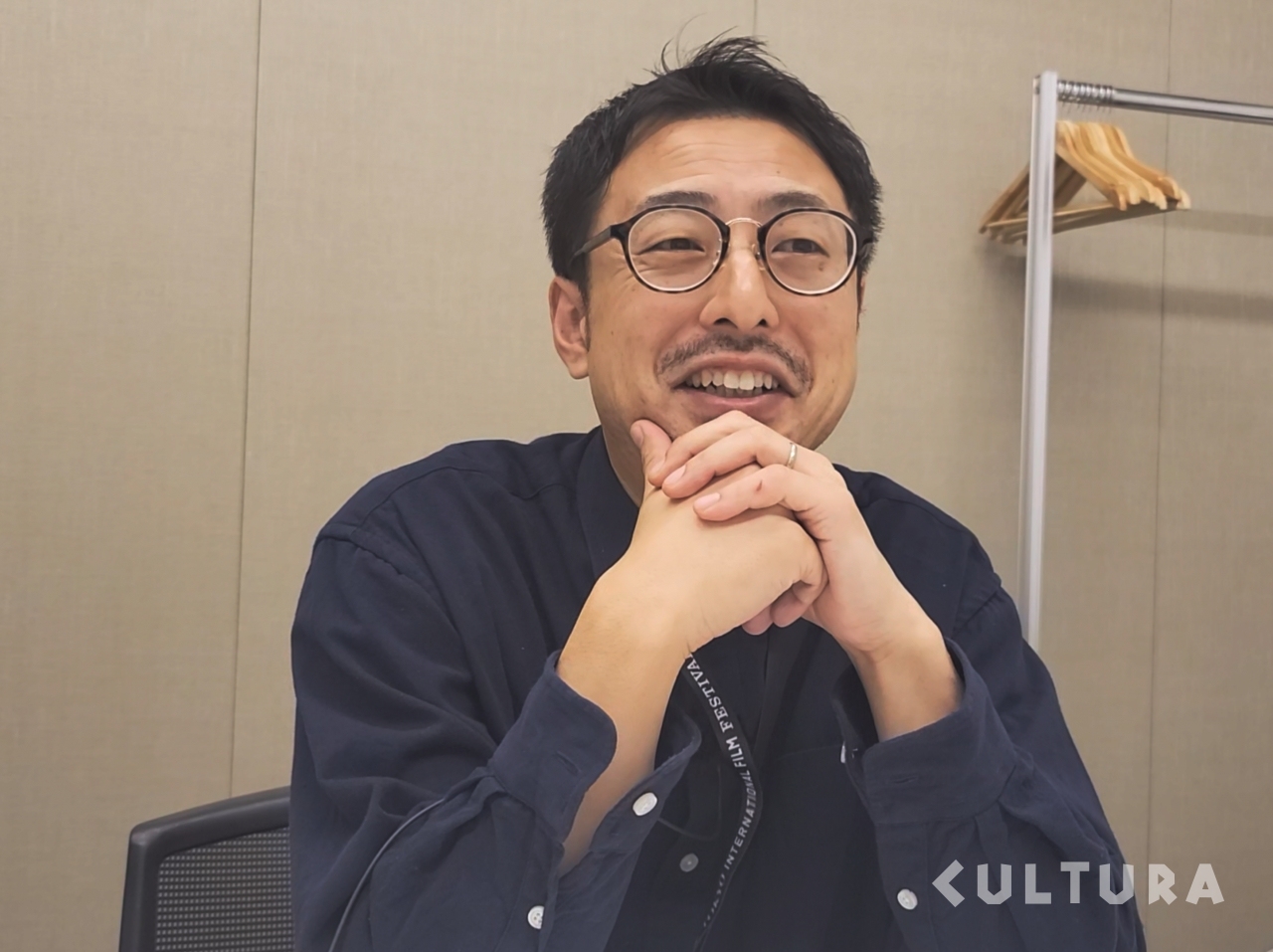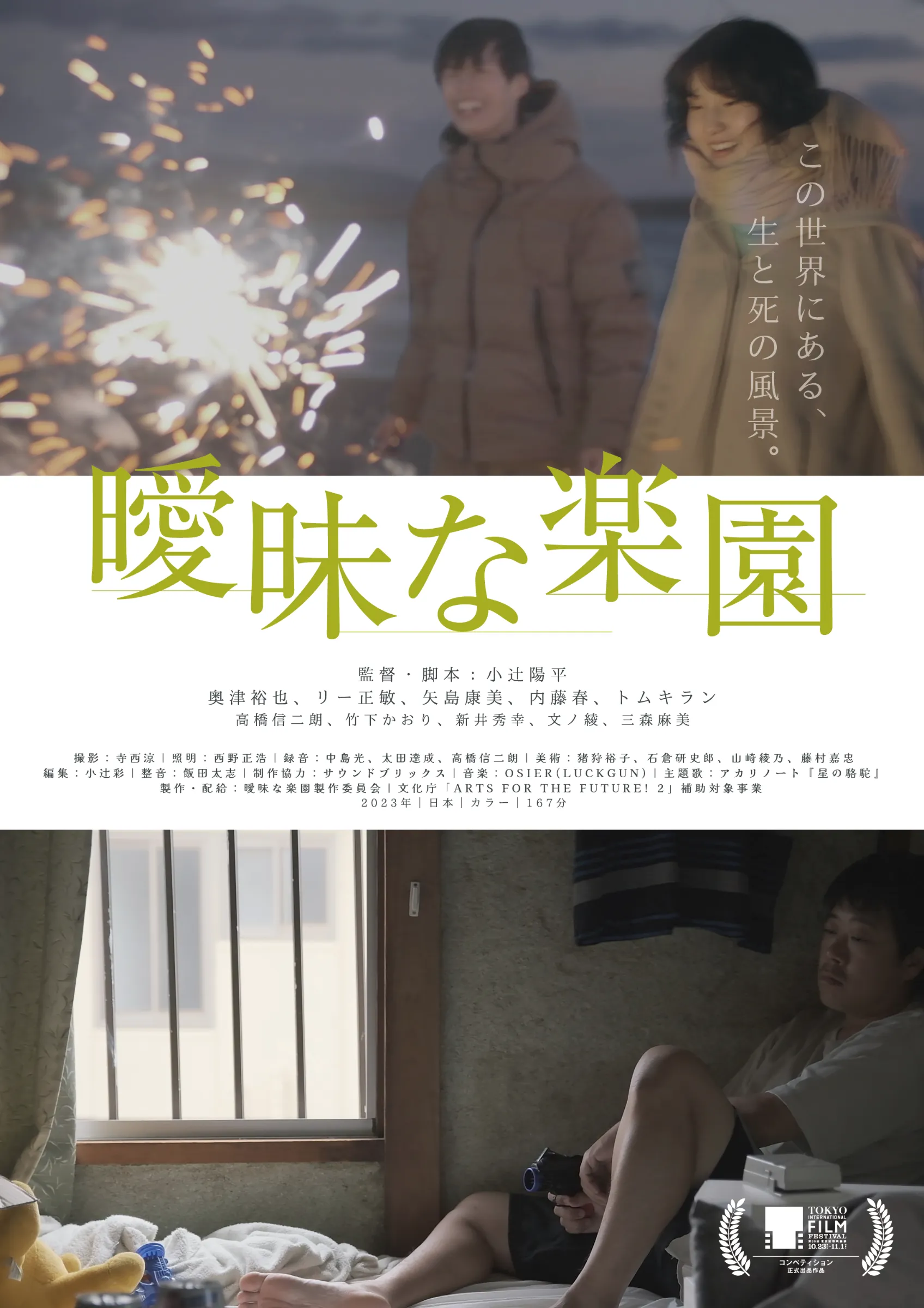
Among 15 films in competition at this year’s Tokyo International Film Festival, three Japanese filmmakers were seeking recognition. One of them, making its international debut with the premiere of a compelling first feature, is A Foggy Paradise曖(昧な楽園) directed by Yohei Kotsuji(小辻陽平).
A Foggy Paradise, released on November 18th, is a nuanced and enigmatic slow-cinema masterpiece that delves into the intricacies of life's uncertainties. Through the tales of Tatsuya(Yuya Okutsu) and his mother(Yasumi Yajima) exploring death, and Kurage(Masatoshi Lee) and Ame(Haru Naitoo) unraveling the mysteries of life, Kotsuji captures extraordinary moments within the canvas of ordinary existence.
Balancing his filmmaking passion with a teaching role at a special needs school, Kotsuji dedicated approximately five years to bringing this film to fruition. I had the opportunity to catch up with Yohei Kotsuji just before the World Premiere screening. He shared that his hands were trembling with excitement upon learning that his work had been selected for the competition. Let’s meet Yohei Kotsuji, the director behind A Foggy Paradise.

Good afternoon. First of all, congratulations on having your first feature in the competition at the Tokyo International Film Festival. As you are new to the scene, can you please introduce yourself to our readers?
Hello, I am the director of A Foggy Paradise. I am making independent films. Actually, I previously worked on a short film titled Room on the Shore, which won an award in the New Talent Competition at the Sendai Short Film Festival. A Foggy Paradise is my first feature film.
The film is essentially composed of two seemingly disconnected stories that, upon closer inspection, reflect each other. How did you come up with this structure, and what was your starting point?
When conceptualizing the film, I envisioned it to be richer with two interwoven stories. After the editing process, I felt this structure added depth, mirroring the complexities of real life. Unlike films that intertwine stories for coherence, I resisted a story-driven approach. I wanted the film to mirror real life, where different segments coexist without forced intersections.

The narrative undergoes a shift from realistic to fantastical, especially with the appearance of lanterns after leaving Tokyo. This transition feels natural and 'magical,' elevating the work.
After that moment, the narrative transforms into a fantasy story, with Kurage transporting the deceased old man, leading to a journey. Ame walks with the ghost of the old man. I want to show they exist in almost different dimensions, yet intersecting.
Thank you for clarifying. I was curious about the old man’s character, and now I understand that he was a ghost.
Yes, I didn’t explicitly explain that anywhere. (laughs)

Water appears in various forms throughout your work, from the mother’s peeing to the son’s tears, rain stagnant water, wetting the old man’s lips, watering a flower pot, and the ocean and lake. These recurring water images seem meaningful. One of the characters is named ‘Rain(Ame)’, and even the lyrics of the song Ame sings are connected to water. Could you elaborate on why you chose to use water imagery?
I’ve been drawn to the idea of water since my previous work, where I used it as a motif. Water is expressive in various ways, and I sense a lot of diversity in it.
You intentionally left many aspects open to interpretation in the film. There are numerous signs in the film through images. For instance, at the beginning, you float a boat on the river, and at the end, a body floats on the lake. Boats seem to represent the characters’ desires. In the first scene, Kurage and Ame discuss the last time they took a boat ride, highlighting the loneliness since these characters don’t have anyone to share the boat with. In the mother’s room, a boat runs on the TV because she has trouble with her legs.
I intentionally left many aspects open to interpretation in the film because there’s no explicit explanation provided. Anyone can interpret the film based on their individual imagination and memories. It’s beneficial for everyone to enrich the story within their own minds. So your interpretation makes me very happy.

Thank you. The sounds in the film play fulfilling roles and act harmoniously. The natural and artificial sounds, along with the background music, contribute to a well-organized atmosphere. Could you share what you paid attention to when designing the sound?
While I often receive comments about the sound, I wasn't specifically trying to create particular sounds. I felt it would be suitable for whatever sounds were captured during the film shoot to be included in the movie. I want viewers to sense that the film is closely connected to our own lives.
As I immersed myself in your film, shades of the opening night film Perfect Days crossed my mind. While the films are distinctly different, both unfold unique portrayals of Tokyo in their own captivating ways. The comparison between these two titles is intriguing, prompting me to explore the inspiration behind the title of your film. What led you to choose the title “A Foggy Paradise?” I'm particularly fascinated by the concept of paradise. Additionally, does the lyric about the white cloud and the gray cloud hold any significance in relation to the title?
Yes, I’m aware that the two films were shot in a similar neighborhood. One of the reasons for naming it was my affinity for films with the word ‘paradise’ in their titles, such as Cinema Paradiso, Jim Jarmusch’s Stranger Than Paradise, and Aki Kaurismaki’s Shadows in Paradise. The addition of 'foggy' introduces ambiguity, intentionally steering clear of a specific narrative. My goal was to capture a scene or vista that is vague and unclear, leading me to settle on the title “A Foggy Paradise.”
Regarding the lyric, it actually originated from a game I used to play with my daughter, which involved finding colors. We would say, “Oh, I found a yellow sign,” engaging in a playful interaction. I incorporated this game into the film by asking the actors to improvise and follow the rules of that game.

Considering it's your first feature, the running time(168 min) is not short. Personally, when I watched it, it didn't feel that long; it felt like a two-hour movie. Nonetheless, making a film with a long running time from the beginning must have been a bold choice. Were there any challenges in creating such a lengthy work?
Creating a long film wasn't particularly challenging for me as I enjoy letting it run for an extended period. I shoot many things over a long duration, appreciating the opportunity to watch the actors at work. However, I did encounter a budget issue at one point. I initially had a budget of one million yen for the entire film, but I was shooting without careful planning. Halfway through, I realized I had exhausted all my funds. I subsequently applied for a grant called AFF at the Cultural Agency, which eventually provided a grant of 2.5 million yen, barely allowing me to continue working.
As we approach the conclusion of our interview, do you have any final thoughts?
Rather than talking focusing solely on the movie, I'd like to express a few words about Haru Naitoo, who portrayed Ame and is here with us. These thoughts might pave the way for potential collaboration in Korea. From a director’s standpoint, Haru was the actress who posed the most questions. She dedicated considerable time to discussing details with me, demonstrating an attentiveness that led me to realize aspects I hadn’t considered. Her charming quality stands out—particularly in how she engages intellectually and comprehends intricacies before the shoot, seamlessly transitioning to emotional acting during filming. I believe this is a remarkable quality she possesses.

After the interview, he went to greet the audience for the first time. His expression showed both excitement and nervousness. Just like the director's desire to "co-create" the story with the audience, I hope that everyone in the theater will face their own lives in the middle of the deep fog.

Jaewon Sheol is the editor-in-chief of Cultura, a Korean cultural magazine, and the publisher of K-Writer, a Korean-US magazine with offices in both Korea and Los Angeles' Koreatown. He specializes in cultural commentary and has written numerous articles, with a particular focus on the film industry. In 2023, he was appointed as an international voter for the Golden Globe Awards due to his recognized expertise.
Photo Courtesy of 2023 Tokyo International Film Festival


